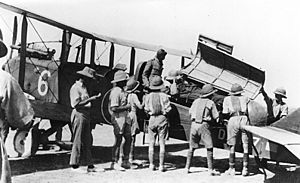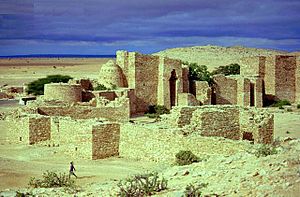Somaliland campaign (1920) facts for kids
Quick facts for kids Fifth Expedition |
|||||||||
|---|---|---|---|---|---|---|---|---|---|
| Part of Somaliland campaign | |||||||||
|
|||||||||
| Belligerents | |||||||||
| Dervish movement | |||||||||
| Commanders and leaders | |||||||||
| Mohammed Abdullah Hassan Haji Sudi † Nur Ahmed Aman † Ibrahim Boghol † Abdullah Shihri † Ismail Mire Diiriye Gurre |
|||||||||
| Strength | |||||||||
| 12 aircraft local gendarmerie 1 battalion (King's African Rifles) |
|||||||||
The Fifth Expedition was the last big fight in the Somaliland campaign. It happened in 1920. This was when British forces finally defeated the Dervish fighters. The main battles took place in January 1920. But the British started getting ready in November 1919. The British side included the Royal Air Force (RAF) and the Somaliland Camel Corps. After about three weeks of fighting, the Dervishes were beaten. This ended their 20-year fight against the British.
Contents
Why the Fight Started
The British had tried to stop the Dervishes before. They had three expeditions between 1900 and 1904. But these attempts were not very successful. In 1913, the Dervishes even defeated British forces. This happened at the Battle of Dul Madoba. After World War I ended, the British focused again on the problems in British Somaliland.
British Plans for Action
In 1919, the British government was worried. There was still a lot of trouble in British Somaliland. Lord Milner, who was in charge of the colonies, thought about sending soldiers. He asked Sir Henry Wilson, a top army leader. Sir Henry said they would need many soldiers. He also said it would cost millions of pounds. This was too expensive after the war.
So, Lord Milner asked the new Royal Air Force (RAF). He talked to Sir Hugh Trenchard, the head of the RAF. Sir Hugh wanted the RAF to stay a separate military branch. He quickly suggested that the RAF could handle the whole operation. Milner thought some soldiers would still be needed. But Trenchard said the local forces already in Somaliland would be enough.
Important leaders met to talk about the plan. These included Winston Churchill, who was in charge of the army and air force. Also there were Leo Amery, a colonial leader, Sir Henry Wilson, and Sir Hugh Trenchard. Sir Henry Wilson did not like the idea of the RAF leading. He did not want the army's soldiers to be used. But Amery and Trenchard promised they would not ask for soldiers. So, Sir Henry agreed to let the RAF lead the mission.
Who Fought: The British Forces
By January 1920, the British had gathered their forces. Here is who was part of the British side:
- "Z Force" from the RAF in Egypt. This group had:
- 12 Airco DH.9A airplanes. These planes were brought to Somaliland on a ship. The ship was called HMS Ark Royal. The planes were used for bombing. One plane was even changed into an air ambulance.
- A group of vehicles. This included ten Ford trucks and two Ford ambulances. They also had six trailers, two motorcycles, and two smaller trucks.
- 36 officers and 183 men. This included the Z Force leader, Robert Gordon. His main helper was Frederick Bowhill.
- The Somaliland Camel Corps. This was a local police group. They were always ready in the area.
- One group of soldiers from the King's African Rifles.
Key Actions of the Expedition
By January 1, 1920, the Z Force built a temporary airfield. It was located at Berbera. They flew their missions from there. On January 21, RAF planes bombed Jideli. Many Dervish fighters had never seen an airplane before. They were very scared by the bombs. They ran away into the hills. During this first bombing, Hassan almost died. A camel nearby saved him from a bomb blast.
Over the next five days, the Z Force destroyed three Dervish forts. They also helped the ground forces. They provided air support and helped with communication. This battle showed how useful airplanes could be. They could bomb enemies and help soldiers on the ground. These ways of fighting are still used in wars today.
On January 28, the Camel Corps took over Jideli. Hassan, the Dervish leader, went back to his main fort. This fort was at Taleh. After attacks from both land and air, the British took Taleh on February 9. The Dervish forces lost many fighters. Their forts were damaged. Hassan escaped with only four of his followers. He went to the Ogaden region. Hassan lost some of his best leaders in this battle. These included his close helper Haji Sudi and Commander Ibrahim Boghl.
What Happened Next
In the months that followed, Hassan did get some power back in Ogaden. But he was never a threat in British Somaliland again. He died naturally in December 1920.
In Great Britain, people were happy about the quick victory. Mohammed Abdullah Hassan had caused problems for a long time. The cost of the 1920 operation was about £77,000. Amery called it "the cheapest war in history." The RAF was very encouraged by how well they did.
In March 1921, there was a meeting in Cairo. Winston Churchill, who was now in charge of the colonies, was there. He and the military leaders decided something important. All British forces in Iraq would be controlled by the RAF. The idea was to use the same air control method that worked in Somaliland. They wanted to use it in a much larger, troubled area like Iraq.



